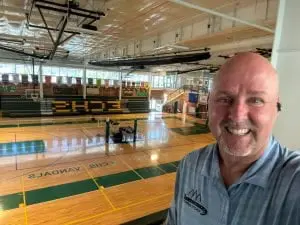 I spend a great deal of time working one on one with leaders. One of my primary goals is to help them spend time reflecting on their current practices, Growth, and areas for continued improvement. One of my favorite questions to ask related to self-reflection actually comes from something my friend and fellow leadership coach, Dr. Frederick Buskey asks. The question is, ‘what are you celebrating today?’ This tool helps us to focus on the positives that are happening, rather than just areas that we want to see improve. The point is this, school leaders need to reflect.
I spend a great deal of time working one on one with leaders. One of my primary goals is to help them spend time reflecting on their current practices, Growth, and areas for continued improvement. One of my favorite questions to ask related to self-reflection actually comes from something my friend and fellow leadership coach, Dr. Frederick Buskey asks. The question is, ‘what are you celebrating today?’ This tool helps us to focus on the positives that are happening, rather than just areas that we want to see improve. The point is this, school leaders need to reflect.
A few days ago, during a conversation with my friend Will Parker, we found ourselves diving into the topic of reflection—not as a luxury, but as a necessity for anyone in leadership. Reflection isn’t just a pause; it’s a powerful recalibration. It’s how we check our compass, realign with our purpose, and grow into the leaders our schools and teams need us to be.
 TL;DR Summary
TL;DR SummaryThe Power of Reflection: Regular leadership reflection is a game-changer for growth. By pausing to assess what’s working (and what isn’t), leaders gain Clarity and learn faster from their experiences. In fact, studies show that leaders who make time to reflect progress more toward their goals on days they do.
“Balcony-Level” Perspective: Great leaders get off the dance floor of daily chaos and step up to the balcony to see the big picture. This concept, inspired by Road to Awesome: The Journey of a Leader, means intentionally taking a higher-level view of your work. From that vantage point, you can spot patterns, celebrate wins, and identify adjustments for your team. In short, balcony-level leadership is about working on your leadership, not just in it.
Intentional Leadership Habits: Early-career school leaders (and new managers in any field) often feel stuck “fighting fires.” The blog emphasizes shifting from firefighting to forward-thinking leadership. Drawing on strategies from the Take Control of Your Leadership course, it suggests actionable habits: schedule regular reflection time, clarify your vision and goals, manage your time with purpose, and nurture a positive school or office culture. These practices help you focus on what truly matters instead of getting lost in day-to-day tasks.
Growth for You and Your Team: Making reflection a routine builds self-awareness and better decision-making. It also helps you support others—when you reflect, you become more intentional in Coaching and developing your staff. Over time, this reflective habit fuels continuous professional growth, stronger team performance, and a leadership style that is proactive rather than reactive. Busy leaders can keep it simple (like a 10-minute journal or a quick “what did I learn today?” chat) – the key is consistency.
 In Road to Awesome: The Journey of a Leader, I wrote about the concept of balcony-level leadership—the idea that we must regularly step away from the floor of the day-to-day chaos and climb up to the balcony, where we can observe, think strategically, and see the bigger picture. From the balcony, we don’t just see what’s happening; we begin to understand why it’s happening. We see patterns, identify challenges before they escalate, and recognize what’s working so we can amplify it.
In Road to Awesome: The Journey of a Leader, I wrote about the concept of balcony-level leadership—the idea that we must regularly step away from the floor of the day-to-day chaos and climb up to the balcony, where we can observe, think strategically, and see the bigger picture. From the balcony, we don’t just see what’s happening; we begin to understand why it’s happening. We see patterns, identify challenges before they escalate, and recognize what’s working so we can amplify it.
But here’s the truth: the balcony doesn’t just appear. We have to intentionally build time and space for it.
In my course Take Control of Your Leadership, one of the most transformative practices we focus on is building a rhythm of reflection. It’s not a once-a-month, when-I-have-time kind of thing. It’s a habit. A leadership discipline. Because if we don’t take time to reflect, we end up reacting. And reactive leadership is exhausting and unsustainable.
So, how do we make reflection part of our leadership practice? Here are a few practical strategies:
 Reflection won’t happen if you just hope to find time. It must be scheduled with the same level of importance as meetings or walkthroughs. Block 10–15 minutes at the end of each day or dedicate part of your Friday afternoon to look back on your week. That time gives you space to pause, take a deep breath, and ask: What moved the work forward this week? Where did I get stuck? When you schedule reflection, you’re making a commitment to your growth.
Reflection won’t happen if you just hope to find time. It must be scheduled with the same level of importance as meetings or walkthroughs. Block 10–15 minutes at the end of each day or dedicate part of your Friday afternoon to look back on your week. That time gives you space to pause, take a deep breath, and ask: What moved the work forward this week? Where did I get stuck? When you schedule reflection, you’re making a commitment to your growth.
 Every leader needs a place that invites thinking. Maybe it’s the quiet of your office after dismissal. Maybe it’s your commute home with the music off. Or maybe it’s a chair on the porch with a notebook in hand. The goal isn’t a fancy setting—it’s finding a space where your mind can slow down enough to process, learn, and lead with intention. Your space becomes your personal “balcony,” and the more regularly you visit it, the more clarity you’ll find.
Every leader needs a place that invites thinking. Maybe it’s the quiet of your office after dismissal. Maybe it’s your commute home with the music off. Or maybe it’s a chair on the porch with a notebook in hand. The goal isn’t a fancy setting—it’s finding a space where your mind can slow down enough to process, learn, and lead with intention. Your space becomes your personal “balcony,” and the more regularly you visit it, the more clarity you’ll find.
 Blank pages can be overwhelming. Use a simple framework to guide your reflection. Try questions like:
Blank pages can be overwhelming. Use a simple framework to guide your reflection. Try questions like:
This process isn’t about judgment—it’s about learning. When you use a structure, reflection becomes easier to sustain and far more meaningful. Over time, you’ll notice patterns that inform better decisions and sharper leadership instincts.
 While much of your reflection is personal, sharing it with others can build trust and culture. You don’t have to reveal everything, but letting your team in on what you’re thinking or learning invites others to do the same. It models humility, vulnerability, and growth. For example, starting a meeting by saying, “Here’s something I’ve been reflecting on…” can create a ripple effect. You’ll begin to foster a culture where people don’t just do the work—they think deeply about how and why they do it.
While much of your reflection is personal, sharing it with others can build trust and culture. You don’t have to reveal everything, but letting your team in on what you’re thinking or learning invites others to do the same. It models humility, vulnerability, and growth. For example, starting a meeting by saying, “Here’s something I’ve been reflecting on…” can create a ripple effect. You’ll begin to foster a culture where people don’t just do the work—they think deeply about how and why they do it.
 Reflection isn’t a checkbox—it’s a commitment to self-leadership. There’s no such thing as “perfect” reflection, and you won’t always have major insights. Some days it’s a quick thought. Other times it might lead to a breakthrough. The key is showing up for the practice. When you give yourself space to think, to pause, to process—it changes how you lead. You become more aware, more intentional, and more present. That’s how leadership grows. That’s how you grow.
Reflection isn’t a checkbox—it’s a commitment to self-leadership. There’s no such thing as “perfect” reflection, and you won’t always have major insights. Some days it’s a quick thought. Other times it might lead to a breakthrough. The key is showing up for the practice. When you give yourself space to think, to pause, to process—it changes how you lead. You become more aware, more intentional, and more present. That’s how leadership grows. That’s how you grow.
 Leaders, we spend so much time trying to be everything for everyone. But the best thing we can do for our teams and our schools is to create space for our own growth.
Leaders, we spend so much time trying to be everything for everyone. But the best thing we can do for our teams and our schools is to create space for our own growth.
Climb the balcony. Look in the mirror. Make reflection your leadership habit—and watch how clarity, purpose, and impact begin to grow.
 If you’re ready to take your leadership team to the next level, let’s talk. Through coaching, professional development, and leadership retreats, I help school and district leadership teams build trust, improve communication, and align their efforts for real impact. Let’s work together to set your team—and your school—up for success in the coming year.
If you’re ready to take your leadership team to the next level, let’s talk. Through coaching, professional development, and leadership retreats, I help school and district leadership teams build trust, improve communication, and align their efforts for real impact. Let’s work together to set your team—and your school—up for success in the coming year.
 Send me a message or visit RoadToAwesome.net to start the conversation.
Send me a message or visit RoadToAwesome.net to start the conversation.
Tune in this Sunday to “Leaning into Leadership” when I sit down with Student Leadership expert Dr. Frank Rudnesky.
Order your copy of Culture First Classrooms: Leadership, Relationships, and Practices that Transform Schools by Darrin Peppard and Katie Kinder today!
 “Culture First Classrooms: Leadership, Relationships, and Practices that Transform Schools is a must-read for anyone passionate about creating meaningful, positive change in schools. This book is an invaluable resource for educators, school leaders, and anyone committed to fostering a culture that empowers both students and teachers.
“Culture First Classrooms: Leadership, Relationships, and Practices that Transform Schools is a must-read for anyone passionate about creating meaningful, positive change in schools. This book is an invaluable resource for educators, school leaders, and anyone committed to fostering a culture that empowers both students and teachers.
One of the book’s most impactful features is its practical, real-world advice from current educators. The strategies outlined are not only thought-provoking but also actionable. From fostering trust between  educators and students to developing leadership practices that create an inclusive and supportive school culture, Culture First Classrooms is packed with tangible steps that any school can implement.
educators and students to developing leadership practices that create an inclusive and supportive school culture, Culture First Classrooms is packed with tangible steps that any school can implement.
The authors were intentional about the project and this is a great guide for educators at all levels and all stages in their journey!! No doubt it will be a game-changer for educators everywhere.” – Jason Ryan
Notifications